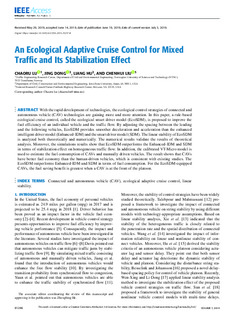| dc.contributor.author | Lu, Chaoru | |
| dc.contributor.author | Dong, Jing | |
| dc.contributor.author | Hu, Liang | |
| dc.contributor.author | Liu, Chenhui | |
| dc.date.accessioned | 2019-08-14T08:08:51Z | |
| dc.date.available | 2019-08-14T08:08:51Z | |
| dc.date.created | 2019-07-12T09:42:17Z | |
| dc.date.issued | 2019 | |
| dc.identifier.citation | IEEE Access. 2019, 7 81246-81256. | nb_NO |
| dc.identifier.issn | 2169-3536 | |
| dc.identifier.uri | http://hdl.handle.net/11250/2608205 | |
| dc.description.abstract | With the rapid development of technologies, the ecological control strategies of connected and autonomous vehicle (CAV) technologies are gaining more and more attention. In this paper, a rule-based ecological cruise control, called the ecological smart driver model (EcoSDM), is proposed to improve the fuel efficiency of an individual vehicle and the traffic flow. By adjusting the spacing between the leading and the following vehicles, EcoSDM provides smoother deceleration and acceleration than the enhanced intelligent driver model (Enhanced-IDM) and the smart driver model (SDM). The linear stability of EcoSDM is analyzed both theoretically and numerically. The numerical results validate the results of theoretical analysis. Moreover, the simulations results show that EcoSDM outperforms the Enhanced-IDM and SDM in terms of stabilization effect on homogeneous traffic flow. In addition, the calibrated VT-Micro model is used to estimate the fuel consumption of CAVs and manually driven vehicles. The result shows that CAVs have better fuel economy than the human-driven vehicles, which is consistent with existing studies. The EcoSDM outperforms Enhanced-IDM and SDM in terms of fuel consumption. For the EcoSDM-equipped CAVs, the fuel saving benefit is greatest when a CAV is at the front of the platoon. | nb_NO |
| dc.language.iso | eng | nb_NO |
| dc.publisher | Institute of Electrical and Electronics Engineers (IEEE) | nb_NO |
| dc.rights | Navngivelse 4.0 Internasjonal | * |
| dc.rights.uri | http://creativecommons.org/licenses/by/4.0/deed.no | * |
| dc.title | An Ecological Adaptive Cruise Control for Mixed Traffic and Its Stabilization Effect | nb_NO |
| dc.type | Journal article | nb_NO |
| dc.type | Peer reviewed | nb_NO |
| dc.description.version | publishedVersion | nb_NO |
| dc.source.pagenumber | 81246-81256 | nb_NO |
| dc.source.volume | 7 | nb_NO |
| dc.source.journal | IEEE Access | nb_NO |
| dc.identifier.doi | 10.1109/ACCESS.2019.2923741 | |
| dc.identifier.cristin | 1711333 | |
| dc.description.localcode | This work is licensed under a Creative Commons Attribution 3.0 License. For more information, see http://creativecommons.org/licenses/by/3.0/ | nb_NO |
| cristin.unitcode | 194,64,91,0 | |
| cristin.unitname | Institutt for bygg- og miljøteknikk | |
| cristin.ispublished | true | |
| cristin.fulltext | original | |
| cristin.qualitycode | 1 | |

